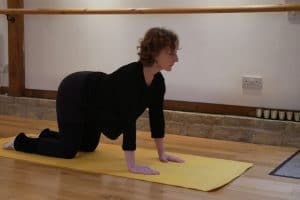Dance Health & Wellbeing
PASSIVE STRETCHES FOR THE ADULT DANCER
Passive stretching is when you stay in a position for a short time and let your muscles relax into the position. Using the weight of the body and sometimes with the help of a prop, such as a yoga block or resistance band, you can gently stretch muscles and joints, while being mindful of your body’s ability and limitations.
- Breathing- slow relaxed breathing helps the muscles to stretch, particularly on the out breath, as it is hard for muscles to tense when you are breathing out.
- A Solid surface could be a kitchen worktop, a solid chair, or a secure barre- basically something you can lean on without it moving.
- Parallel position of the feet is when your toes are pointing forward and the feet are slightly apart as if on parallel tramlines.
- Always work within your abilities, do not continue an exercise if it is causing you pain.
STANDING PASSIVE STRETCHES:
Standing Thigh Stretch
Do this exercise holding onto a solid surface or chair to help you balance. Standing with your feet in parallel bend your right knee and lift your foot towards your bottom and clasp the front of your right foot in your palm. With your knees together gently pull your foot towards your bottom. Try and breath, relaxing the front of your thigh on you raised leg, letting gravity pull your knee toward the floor. Try holding your foot there for 5 long breaths, mindfully relaxing the thigh a little more on each outbreath. Do the same for both legs. Do not do this exercise if it causes any pain in your knees!
Standing Calf stretches
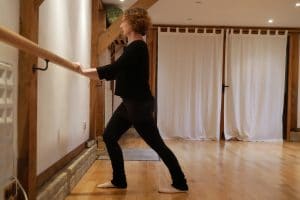
1/With both hands on a solid surface, standing in parallel position. Step the right leg back with the foot still parallel and bend the front knee so you are standing in a lunge. Gently stretch the back heel towards the ground. Make sure your hips are facing forward and not tilted towards the ground. The shoulders are dropped and stomach muscles engaged. Feel like your belly button is pulling in towards the spine.
*For an extra stretch for tummy muscles, look up and lift your chest up to the ceiling, still pressing forward through the front knee and keeping the lower back long.
2/You’ll need a yoga block or large, solid book and to hold onto a solid surface for this stretch. Stand less than arm’s length from your surface with your yoga block on the floor about a foot (or 40cms) away from what you’re holding onto. Stand on the block, or book with your feet in parallel, with only the front half of your foot on the block and your heels moving towards the floor. Breathing slowly in and out for 5 breaths try and relax the calf muscles, allowing the heels to stretch down towards the floor.
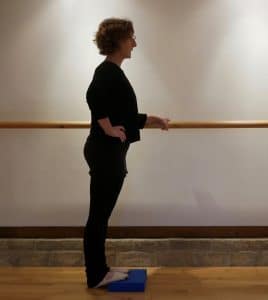
- This stretch can also be done one foot at a time which can be more intense.
- You can strengthen and stretch by rising up from the heel down position all the way to a rise on your toes and back down again. You can also do this on one leg only but take care to build up to this over a few days or weeks.
- Tips: make sure your weight is forward as leaning back puts strain on the lower back and joints, and that you are engaging your tummy muscles.
Seated spinal stretches
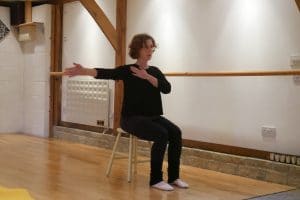
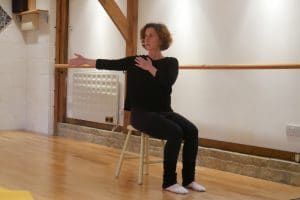
Sit on the edge of an upright chair with your feet flat on the floor and legs in a parallel position. Put your right hand across your chest to touch the front of your right and open your left arm to the side at shoulder height, palm facing forward. Looking at your outstretched hand continue to twist to the left, whilst pulling the stomach muscles in and keeping the back straight. Gently press down through the sitting bones and slowly unwind to face front again and repeat on the other side. Keep your feet parallel and knees apart. Try and breath out as you increase the twist and breath in as you unwind to face the front. This stretch can also be done sitting cross legged on the floor.
Passive Floor stretches
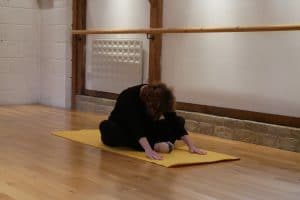
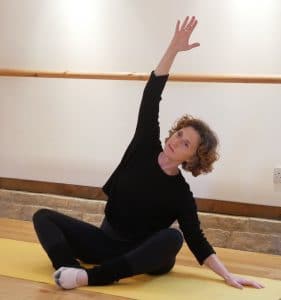
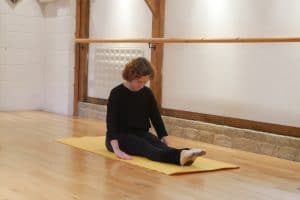
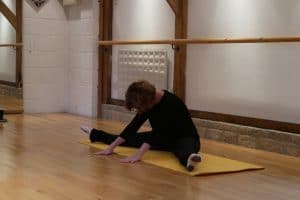
These can be done on a mat, carpet or towel ( bare floor may be cold, slippey and too hard)
Hip and hamstring stretches:
- Sit upright with the soles of the feet together and your hands holding your ankles. Pull the tummy muscles in to support the spine, drop the shoulders and breath in slowly and as you breathe out gently bend over with the top of the head aiming towards your feet. Let the weight of your head pull you down. Try to curve over, rather than collapse. Take three more breaths in and out trying to relaxed a little more every time you exhale, than slowly uncurl to sit upright again.
- You can do the same exercise with your feet stretched out in front of you, but this time start with you fingers touching the floor either side of your hips and gently slide them forward along the floor reaching forward. Again, try to relax your neck and don’t hold your head up. You can do this exercise with your legs slightly bent or straight. Work within your own ability and you will find that you gradually become more flexible over time without strain or injury.
- To extend yourself further you can do the same exercise with your feet apart in a V shape, kneecaps facing the ceiling. Start off upright again, with your tummy muscles engaged, this time have your hands in front of you, fingertips on the floor and gently reach forward. Your can lean on your hands and take this stretch slowly as it is one of the deeper stretches we will be doing.
You may find using a yoga block under your hips is easier:
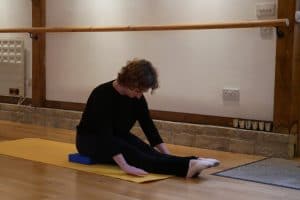
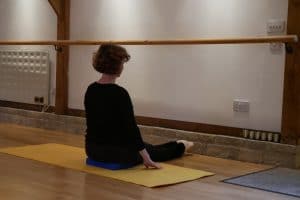
Groin and hip stretch:
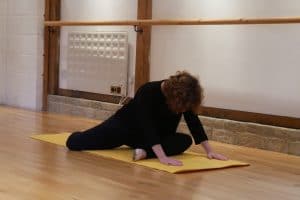
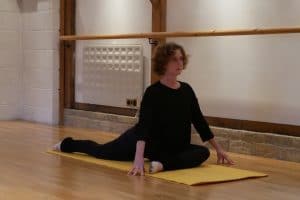
Start by sitting upright with the soles of your feet together. Gently bring your right foot behind you, so both your legs are bent at right angles; one leg in front with the front of the ankle facing up, the other leg behind with the front of the ankle facing down. Support yourself by having your arms either side of you and resting the fingertips on the floor. In contemporary dance this is called fourth position. With your hands touching the floor either side of your body slide your hands in front of you whilst bending forward, the top of your head aiming forward towards the floor. Leaning on your hands, gently allow your weight to come forward and stay there for five breaths. On each exhale try to relax a little more, deepening the stretch. Again work within your comfort zone you should feel a stretch but not pain. Increase the stretch by extending your back leg and folding forward over your front leg.
Repeat this exercise swapping legs so now your right leg is in front of you and your left leg is behind you.
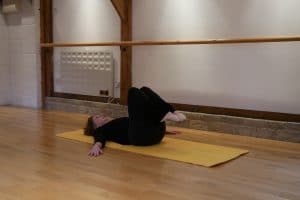

Spine twist, lying on the floor
Lie on your back with your knees bent up to the ceiling and your feet flat on the floor in parallel position. Hug your knees to your chest so that your feet come off the floor. Then put your arms on the floor in an A shape, away from the sides of your body. Keep your knees to your chest, then let your knees slowly move to your right, whilst turning your head to the left. Each time you exhale let your knees move further to the right, keep drawing you belly button in towards your spine. After three breaths bring your knees back to centre, then send them to your left as your head moves to the right. Make sure your neck and shoulders are relaxed and your movement slow and smooth to ensure a safe, gentle stretch.
Gentle neck stretch
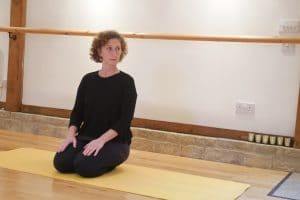
Hamstring stretch. Using a stretchy band will make this exercise a little easier:

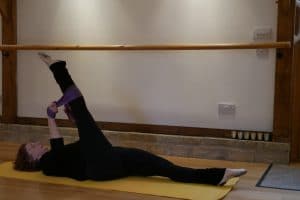
Back stretch

